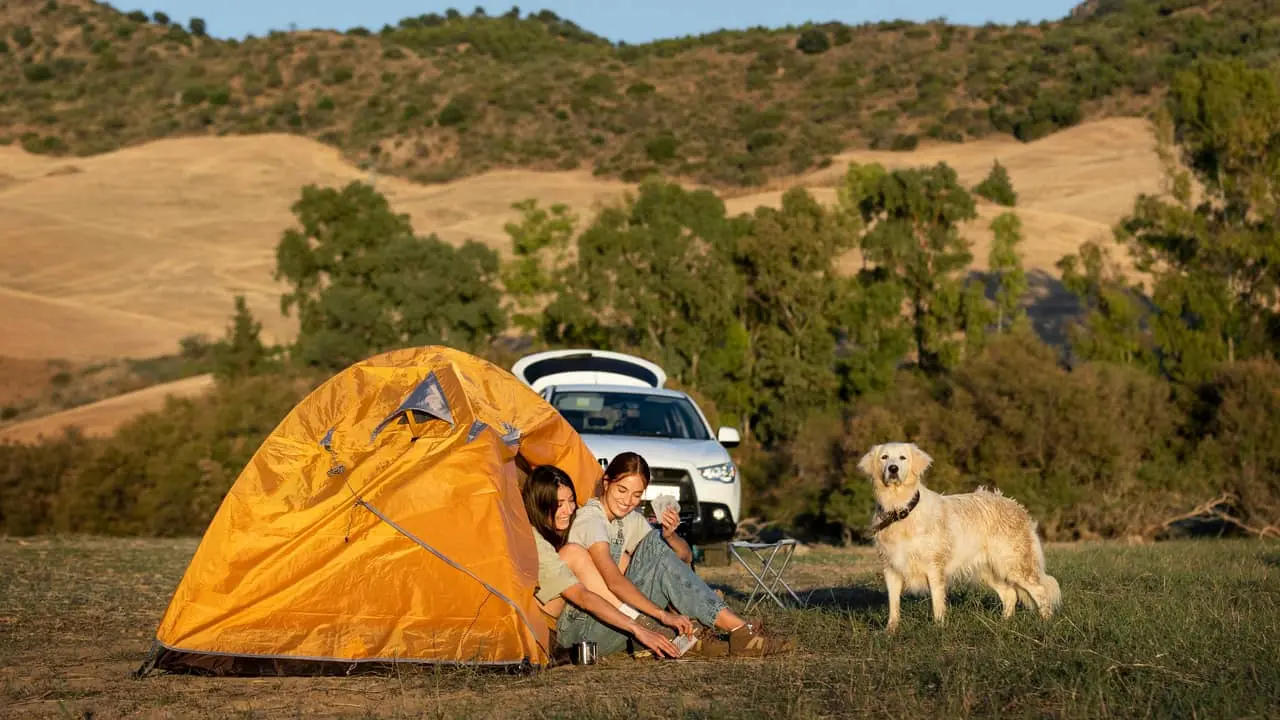
Camping With a Dog – Unleash the Joy Outdoors
For dog owners, the idea of bringing your four-legged friend along on camping trips can be incredibly beneficial for both you and your pet. It offers a chance to strengthen the bond with your dog, build trust, and engage in activities that keep them healthy and mentally stimulated. Not to mention, it keeps you more active and can even improve your social skills. Whether you’re hiking through nature trails, cooking by the campfire, or simply relaxing in a peaceful environment, the experience of camping with your dog can lead to lasting memories.
On the other hand, it’s also worth considering how much cheaper it can be to take your dog on a camping route than to pay for a hotel. Our first time camping with our dog, Kirby, was filled with lessons and hurdles, but we learned a lot about how to survive the adventure. From setting up the tent to exploring the campground or a country-wide park, camping with a dog offers an opportunity to bond and have fun, all while giving your dog plenty of physical exercise and mental stimulation. So, if you’re looking for an adventure that’s as fun as it is rewarding, camping might just be the perfect vacation destination for you and your canine companion.
Table of Contents
TogglePreparing for Your Camping Trip With Your Dog
Before your camping trip, it’s important to prepare your dog for all the different environments and situations you might encounter, like car rides, meeting animals, or spending time with groups of people in nature. I recommend doing a trial run in your backyard to help your dog get used to a tent and being tied up for an extended amount of time. This will help ease any anxiety and make your dog feel more comfortable in the unknown. For us, we set up a fire pit and made food, going the nine yards to see how Kirby would handle it. This gave us a great chance to observe how he’d react and gave him the exposure he needed to have a safe and enjoyable outing.
Check Campground Regulations and Guidelines
Before you head to your campsite, it’s important to check the specific rules and regulations of the campground. Not every location is pet-friendly, and each place has its own pet policy. Here are a few things to keep in mind:
- Many campgrounds across the United States allow dogs, but always check their rules before arrival.
- Leash requirements are common at most pet-friendly places. Typically, a leash should be six feet long for easy control, and retractable leashes may not be allowed.
- Ask about barking ordinances. Some campgrounds may have noise restrictions if your dog barks uncontrollably or excessively.
- Ensure your dog’s behavior is suitable for the campground. Aggressive behavior can lead to being asked to leave, so if your dog doesn’t respond well to other dogs or new surroundings, it’s better to leave them at home.
- Look for campgrounds that offer dog-friendly amenities like those at KOA locations to keep your dog entertained.
- Keep an eye on the weather. Rain or scorching heat can make your trip uncomfortable. Ensure there’s plenty of shade, a cooling mat, or even a kiddy pool for your dog to cool off.
Choosing the Right Campsite
When it was our first time camping with Kirby, we learned the hard way about the importance of picking the right site. I booked a spot near the water spigot and just a short walk to the bathrooms, but at night, people would cut through our site to use the restrooms. This made Kirby growl and bark at the noises and flashlights, which was not ideal. Never again would I choose a site so close to a high-traffic area!
Now, I always suggest booking a site that backs up to the woods or a corner site where there won’t be many people walking through. While it may mean a farther walk to the restrooms, it makes keeping your dog quiet at night much easier. Though it may seem like a bit of an inconvenience, the extra distance is worth it for a peaceful, stress-free camping experience.
Camping Pet-Friendly Essentials and Gear
When you’re heading out on a camping trip with your dog, it’s important to pack more than just the usual camping gear. To make sure your dog has a safe and memorable time, here’s a list of pet-friendly essentials you’ll need:
- Dog food and a bowl for water.
- Treats to keep your dog happy and satisfied.
- Prescription medication (if applicable) to ensure your dog stays healthy.
- A stake or tether to keep your dog secure at your campsite.
- Extra towels for cleaning up after your dog.
- A first-aid kit specifically for your dog’s needs.
- Outdoor-safe toys to keep your dog entertained.
- A leash to ensure control when out and about.
- A current photo in case your dog gets lost.
- Vet records and medical information in case of emergencies.
- An ID tag and waste bags for responsible pet care.
Shopping for dog camping gear can be a lot of fun, and there are some must-have items to make your experience more comfortable:
- A camping bed or mat for your dog to sleep on.
- An elevated pet cot to keep your dog off the ground.
- A collar light bulb for visibility at night.
- A sun shade shelter to protect your dog from the sun.
- Durable outdoor toys for playtime.
- A tick remover to keep your dog safe from pests.
- Food and water bowls to keep your dog nourished and hydrated.
By preparing with the right essentials, you can ensure both you and your dog have a fantastic camping adventure.
Tips for Camping With Your Dog
Planning Ahead for Camping With Your Dog
A spontaneous trip with your furry best friend might sound like a dream, but planning ahead is key to making sure you both have a safe and enjoyable camping experience. Before you go, check the campground’s pet policy and rules to make sure they are dog-friendly. You’ll also want to schedule a veterinarian check-up for your dog to ensure they’re healthy for the trip. If you’re traveling during peak travel times, it’s a good idea to reserve a campsite early. Planning your travel route is also essential, so make sure there are plenty of pull-off opportunities for bathroom breaks.
When getting ready, invest in high-quality gear like harnesses and collars, and don’t forget to prepare your dog for interactions with other people and pets. For our first time camping with Kirby, we learned the hard way by forgetting to clip his nails, which caused us a lot of worry about him poking holes in the tent and air mattress. To avoid that, always make sure your dog’s nails are clipped before the trip. We also used a folded blanket to protect the spot where Kirby sleeps on our bed in the tent, as getting him to sleep anywhere else was nearly impossible.
Take a Picture of Your Dog
Before heading out on your camping trip, it’s a good idea for dog owners to take a clear picture of your dog, especially in case they get loose. Make sure the picture is taken straight on in natural lighting, highlighting any distinguishing features like spots or markings. This will help if you need help finding your dog later. It’s also smart to print a copy of the photo and keep it with you while camping. If you’re at the campsite, place your dog’s spot in view of the picnic table and fire pit, while making sure they stay within a six-foot radius of you to avoid them running into the tent or getting tangled with anything, as most campgrounds have a leash policy.
Never Leave Your Dog Unattended
When you’re camping or traveling with your dog, it’s essential never to leave them unattended. Whether you’re in the car, at the campsite, or enjoying activities at dog parks, always stay close. Even if your dog behaves well around other dogs or people, you never know when something unexpected might happen. It’s important to monitor your dog at all times, especially when they’re playing in pet areas or at the dog park.
To avoid worrying while setting up your tent, make sure your dog has a safe spot where they can relax. Also, give them quick access to water so they stay hydrated and comfortable while you focus on setting up camp. Keeping them safe and comfortable will lead to a much more positive experience for both of you.
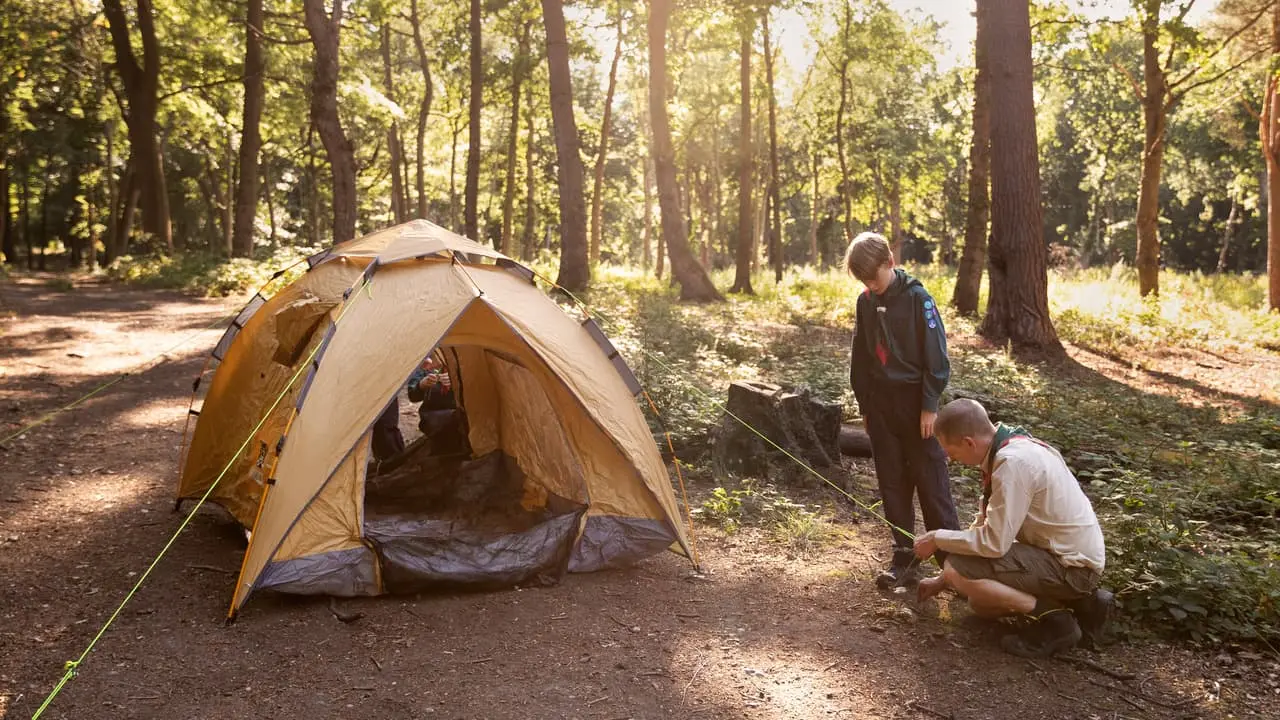
Upgrade Your Gear for a Better Experience
Upgrading your gear for camping with your dog can make a huge difference. Consider getting a leash and harness specifically for swimming—these come with anti-rust clips and even float in water, making it easier to grab. Also, a reflective harness helps you and others see your dog in the dark, ensuring safety during nighttime walks. On our first time camping with Kirby, we learned the hard way that setting up a tent and getting him to do his business in the dark led to a nightmare of waking up every 2 hours. To avoid that, now I make sure to take him to a familiar area during daylight, where he can comfortably see and understand his surroundings, making the trip more enjoyable and safe.
Watch Out for Allergies
When you’re camping with your dog, keep an eye out for signs of seasonal allergies. Dogs can experience symptoms like sneezing, itching, wheezing, or even an ear infection. If you notice these signs, it’s important to talk to your vet about possible treatment options and try to limit your dog’s exposure to high-pollen times. Also, if you’re camping with children, be aware that kids may not always be polite when they want to meet your dog. If your dog is anxious or not super friendly, consider putting up a sign on a tree that says, “Please don’t disturb the dog,” to avoid any unwanted interactions.
Keep Your Dog Entertained and Cool
When camping, it’s important not to rely solely on the outdoors for stimulation. While your dog will enjoy the chance to roam and play, the weather can change quickly, and your dog might get bored. Be sure to plan ahead by packing their favorite outdoor-safe toys, like rope chews, plushies, and tennis balls. Since your home away from home is completely outdoors, you’ll need to make sure your dog stays hydrated and cool. Always check the weather forecast before your trip and pack accordingly. Bring a cooling mat, a sunshade device, and have cold water available at all times. If it’s a hot weekend, consider bringing a small kiddie pool so your dog can cool off.
Providing Extra Hydration for Your Dog
When camping outdoors, it’s important to ensure your dog stays hydrated, especially since they need more water than usual due to temperature and activity level. You can calculate how much your dog needs based on their weight—generally, they need about one ounce per pound of body weight each day, but outdoors, they might need even more. Bring a collapsible water bowl for the trip so your dog can drink on the go, and set up a large outdoor-safe bowl at the campsite to keep them hydrated. Make sure to check the bowl often for any dirt or leaves and place it in a shaded area to keep the water cool. During downtime, toys like the ones I bring for Kirby—that are easy to wash off—can help keep him entertained while we’re cooking or relaxing in the hammocks. Also, if your dog is in the tent at night, remember to make sure they’re comfortable and not disruptive while you set up camp.
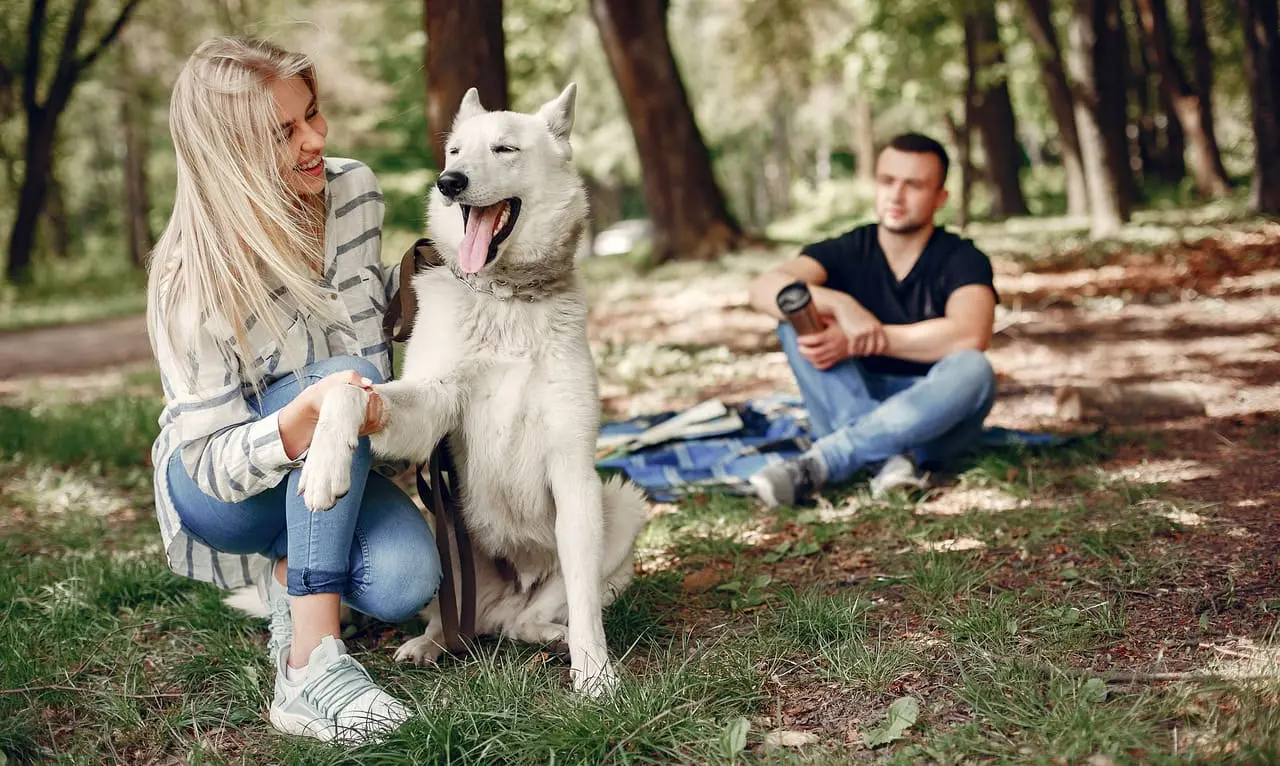
Try a Trial Run Before the Real Camping Trip
If it’s your dog’s first camping trip or they are new to the outdoors, a trial run can help you prepare. You can start by having a backyard campout to see how your dog responds to the new experience. Set up a fire ring, spend time outside, and keep your dog leashed or secured at all times. Invite friends or family for social interaction and see how your dog handles being around other people or pets. This controlled environment allows you to assess your dog’s behavior and make any adjustments to their social skills or leash behavior before you head out on the real deal. This way, you’ll know if your dog is comfortable and ready for the adventure!
Keep Your Dog Secure at All Times
When you’re camping with your dog, it’s important to always keep them leashed to follow campgrounds’ leash requirements and ensure their safety. This is especially true during your dog’s first walk around the campground, as they may get overwhelmed or excited by all the new sights, sounds, and pets. A leash keeps them by your side, even during activities, whether on-site or away from the campground. There are some exceptions, such as when your dog is sleeping in a secure place overnight or at a campground with a fenced-in dog park or pet play area like KOA Paw Pen Sites.
Watch Out for Wildlife
When you’re on a camping trip with your dog, it’s important to be aware of wildlife and other potential hazards. This includes both animals and plants that might pose a danger. While you’re enjoying outdoor recreation and exploring your surroundings, make sure to keep an eye out for things like stagnant water, lakes, ponds, or rivers that could be infected with harmful blue-green algae. Never let your dog drink from stagnant water, and always research the local plant life to know how to identify poisonous plants before going on hikes or walks. Keep your dog safe by staying cautious and informed during your adventure.
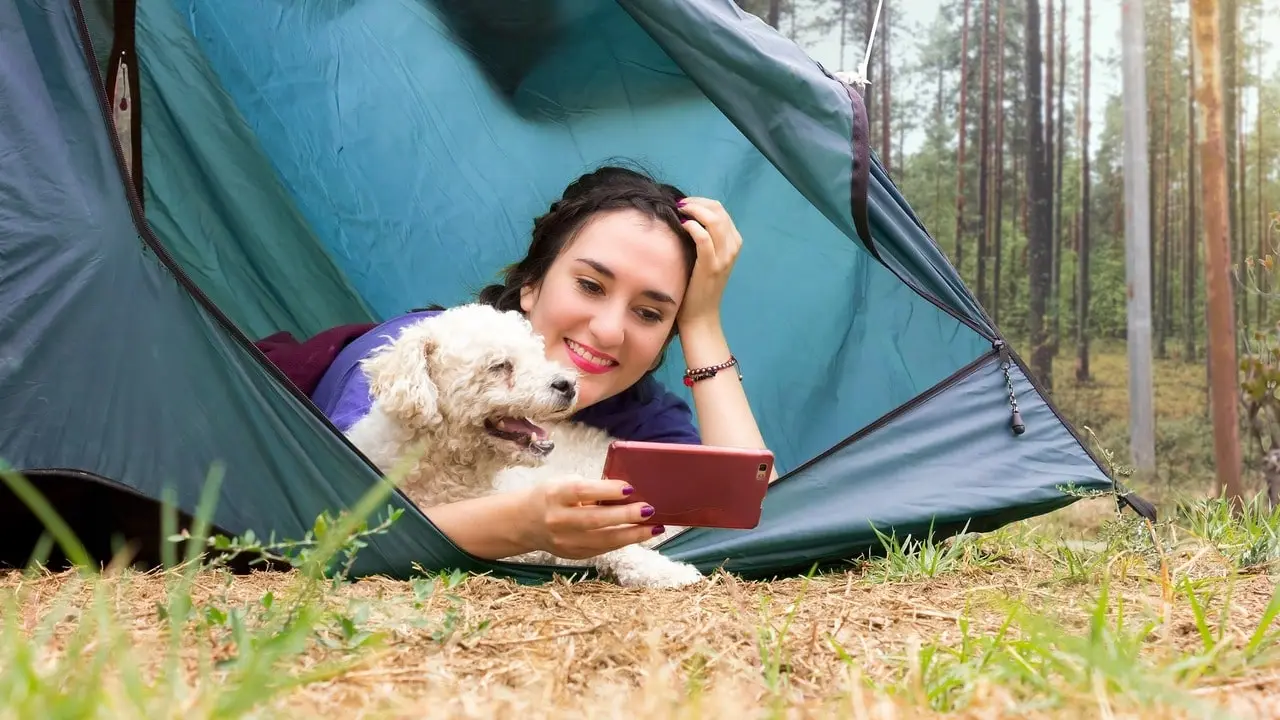
Plan Dog-Friendly Activities
When you’re camping with your dog, the goal is to enjoy quality time together, making it fun for both of you. One way to do this is by planning dog-friendly activities like hitting the trails, visiting the beach, or going boating or kayaking. If you’re near local parks, take a walk and enjoy the natural surroundings. Don’t forget to bring along some snacks and enjoy an outdoor meal with your dog, or even engage in some outdoor games to keep both of you entertained. These activities will help you both feel connected while also exploring the beauty of nature.
However, not all places allow pets, so always double-check the rules for attractions like state parks, national parks, or private trails, as many of them do not permit pets. Before you head into nearby towns or cities for a public stroll, make sure to review local leash laws and bring enough dog waste bags to clean up after your dog. Planning ahead will ensure a smooth and enjoyable camping trip for both you and your furry friend.
Dog Safety While Camping
When camping with your dog, keeping them safe is key to a fun trip. Since dogs can get overheated in the sun, especially dark-colored dogs or those with thick hair, it’s important to provide a cool area during the hottest part of the day. Always monitor your dog’s behavior while playing or on walks. If you notice signs like panting, heavy breathing, restlessness, or a bright red tongue, it’s time to take action. Make sure cold water is always available and use a digital thermometer from your first-aid kit to check their temperature. If it reaches 104 or higher, your dog could be overheating. Move them to a cool location, like shade or air conditioning, and offer a bowl of cold water. If symptoms worsen, such as lethargy or trouble breathing, take them to an emergency veterinarian as they may be at risk of heat stroke.
Protect Your Dog’s Paws
Your dog’s pads can be sensitive to extreme temperatures and abrasive materials while camping. Things like hot pavement, salt-melting ice, burrs, sharp rocks, or even broken glass can cause discomfort or injury. To keep your pup’s paws safe, consider using a paw protectant or investing in booties to shield them. If your dog has never used booties or a paw protectant, it’s important to let them acclimate at home first before your camping trip. Protect their paws by taking these precautions to ensure a more comfortable and safe adventure.
Dog Identification
When camping with your dog, it’s essential to have physical ID tags in addition to having them microchipped at the vet. Make sure your dog wears a tag on their collar and possibly inside their harness for extra identification. You might also want to include a temporary ID tag with your campsite number, so people can get ahold of you if they happen to find your dog. It’s a good idea to have multiple types of identification for added safety and peace of mind during your adventure.
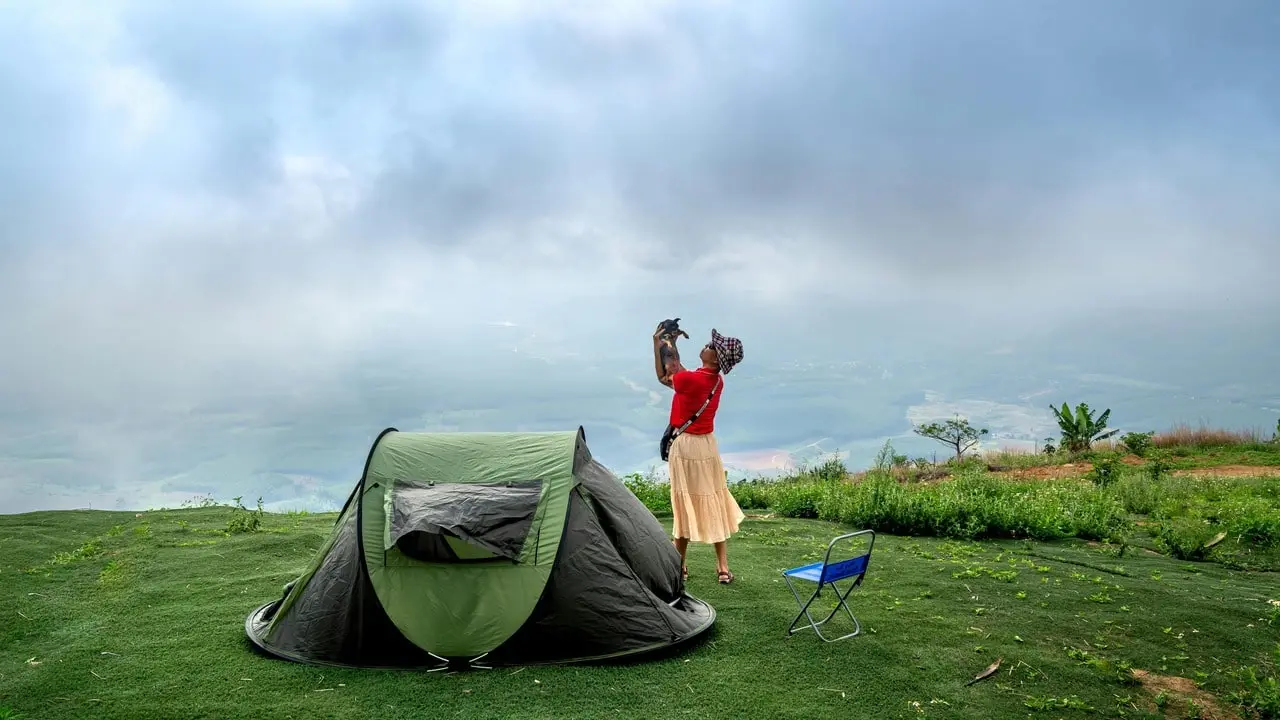
Frequently asked questions (FAQ)
What To Do With Your Dog While Camping?
During your camping trip, it’s a great chance to bond with your dog and enjoy recreational opportunities. Pet-friendly campgrounds offer the perfect space for socializing and letting your dog meet new friends. You can enjoy walks and participate in various activities, all while brushing up on training commands or teaching your dog new tricks. Remember, the most important part is to spend time together, disconnecting from the hustle and bustle of everyday life while traveling and strengthening your connection.
Can Dogs Sleep in Tents?
Tent camping with your dog can be a bit challenging, but it’s definitely not impossible. When rooming with your dog, choosing a bigger tent is key, as it makes the space more comfortable and less suffocated for both of you, especially on rainy days. Larger tents are ideal for medium-breed dogs and large-breed dogs who need more space. To ensure security, always zip and secure the tent when sleeping to prevent your dog from trying to escape. If you’re worried about their behavior, placing your luggage and gear in front of the door can help block the exit. If your dog is sensitive to noise, like barking at sounds, using a battery-operated fan or white sound can help calm your dog before bed. Keep your sleeping arrangements similar to home to make the transition smoother — bring along their dog bed, crate, or give them space on your air mattress or sleeping bag. However, if temperatures are extremely hot or frigid, it might be better to stay in a KOA campground with Camping Cabin rentals for more comfortable lodging.
Where Can I Take My Dog Camping?
When you’re planning a camping trip with your dog, it’s important to first check the pet policy for any campgrounds you’re considering. Many websites list these policies, but it’s always a good idea to call ahead and double-check specific rules regarding breed and behavior guidelines. If you’re heading to a hiking trail, beach, or a national park, each place may have its own policies about pets, so make sure to check the regulations beforehand.
No matter if you’re headed to the mountains, coast, or even an urban hotspot, there are plenty of dog camping opportunities available. As long as you follow the local and campground regulations, you can bring your dog to different places and enjoy your outdoor adventure together. Each location is unique, so always check individual sites for their specific pet guidelines before heading out.
How Do I Take a Dog Camping in a Car?
When taking your dog on a car ride to a campground, it’s important to ease them into the experience, especially if they get anxious. Start with small rides to help them get used to being in the car. Gradually increase the time spent in the car to make them feel more comfortable. Ensure the back seat is cozy by adding blankets and pillows. Bring along your dog’s favorite toys and a spill-proof water bowl for easy hydration. If your dog gets restless or anxious, take breaks at a pull-off spot or rest area for bathroom breaks. Use training treats as positive reinforcement to make the trip enjoyable for both of you.
What If I Am Camping With Multiple Dogs?
Camping with more than one dog can be a fun way to keep each dog entertained, especially during car rides. If you’re planning to bring multiple pets, it’s important to double-check with your chosen campground to ensure there’s no pet limit policy in place. Additionally, you might want to bring along a friend or family member to help make walks and recreation activities easier and more enjoyable for everyone. This can also ensure that your dogs get the attention and care they need while you enjoy your trip.
Conclusion
Camping with your dog can be a rewarding experience that strengthens your bond while enjoying the outdoors. Whether you’re going on a weekend trip or a longer stay, careful planning and preparation are essential for a safe and enjoyable adventure. From choosing the right campground to keeping your dog’s safety and comfort in mind, making the experience positive for both you and your pet is key.
Remember to always double-check policies, pack the necessary supplies like water bowls, and keep an eye on your dog’s behavior during activities. With a little extra effort, you can enjoy a stress-free trip and create lasting memories while camping with your furry friend.
